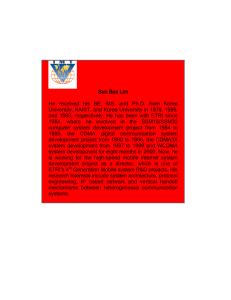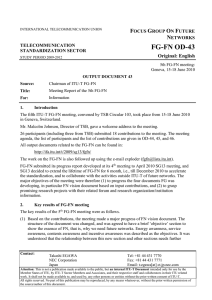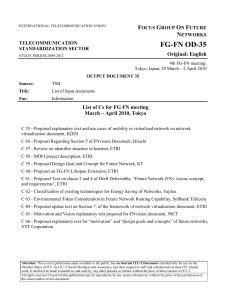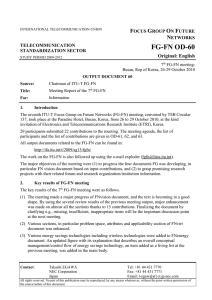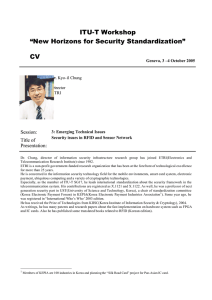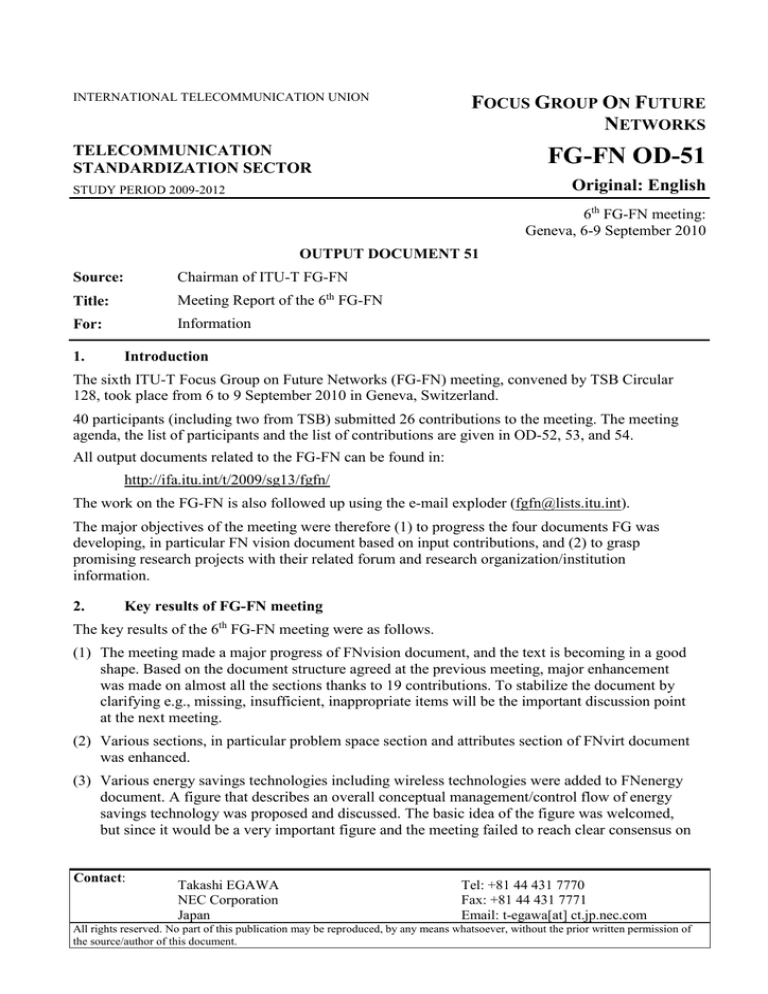
INTERNATIONAL TELECOMMUNICATION UNION
FOCUS GROUP ON FUTURE
NETWORKS
TELECOMMUNICATION
STANDARDIZATION SECTOR
FG-FN OD-51
Original: English
STUDY PERIOD 2009-2012
6th FG-FN meeting:
Geneva, 6-9 September 2010
OUTPUT DOCUMENT 51
Source:
Chairman of ITU-T FG-FN
Title:
Meeting Report of the 6th FG-FN
For:
Information
1.
Introduction
The sixth ITU-T Focus Group on Future Networks (FG-FN) meeting, convened by TSB Circular
128, took place from 6 to 9 September 2010 in Geneva, Switzerland.
40 participants (including two from TSB) submitted 26 contributions to the meeting. The meeting
agenda, the list of participants and the list of contributions are given in OD-52, 53, and 54.
All output documents related to the FG-FN can be found in:
http://ifa.itu.int/t/2009/sg13/fgfn/
The work on the FG-FN is also followed up using the e-mail exploder (fgfn@lists.itu.int).
The major objectives of the meeting were therefore (1) to progress the four documents FG was
developing, in particular FN vision document based on input contributions, and (2) to grasp
promising research projects with their related forum and research organization/institution
information.
2.
Key results of FG-FN meeting
The key results of the 6th FG-FN meeting were as follows.
(1) The meeting made a major progress of FNvision document, and the text is becoming in a good
shape. Based on the document structure agreed at the previous meeting, major enhancement
was made on almost all the sections thanks to 19 contributions. To stabilize the document by
clarifying e.g., missing, insufficient, inappropriate items will be the important discussion point
at the next meeting.
(2) Various sections, in particular problem space section and attributes section of FNvirt document
was enhanced.
(3) Various energy savings technologies including wireless technologies were added to FNenergy
document. A figure that describes an overall conceptual management/control flow of energy
savings technology was proposed and discussed. The basic idea of the figure was welcomed,
but since it would be a very important figure and the meeting failed to reach clear consensus on
Contact:
Takashi EGAWA
NEC Corporation
Japan
Tel: +81 44 431 7770
Fax: +81 44 431 7771
Email: t-egawa[at] ct.jp.nec.com
All rights reserved. No part of this publication may be reproduced, by any means whatsoever, without the prior written permission of
the source/author of this document.
-2FGFN OD 51
its details, it was added to the document as a living list item. This will become a major
discussion point in future meetings.
(4) A project description was generated.
(5) Joint meeting with Focus Group on Cloud Computing (FG-Cloud) was held, and the areas and
methods for future collaboration were discussed. It was recognized that there were areas, e.g.,
virtualization, that both FGs have strong interests. However, since both FGs have severe time
limitations, it was agreed not to establish special collaboration groups or procedures, but to
collaborate by exchanging liaisons.
3.
Discussions
3.1
Vision aspects
C93,NEC,Proposed change on Introduction of FNvision
This contribution was accepted as is.
C99,NICT,Proposal of text addition to Objectives part on FNvision document
Accepted with the understandings that service awareness section should mention the properties such
as service quality or security.
C85,Hitachi,Additional text for Section 7 and 8
This contribution was accepted with an editorial change.
C92,NICT,Proposal of additional text for Section 7
Accepted with minor modification.
C94,Brazil,Economic Incentives in Future Networks
It was pointed out that FG-FN, a focus group under SG13, should not discuss financial issues. It
was also pointed out that there were always technical issues behind the requirements/solutions of
financial issues, and that such technical issues were appropriate for FG-FN discussion.
Since the topics the contribution mentioned were obviously important and since these could become
properties that characterize Future Networks, it was agreed to rewrite the mentioned topics to make
it a technical description and include into the deliverables with appropriate new section name.
C100,ETRI and KT,Revised text on Economic Incentives in Section 7 of OD-47
The discussion on C94 was also applied to this contribution, and it was agreed to accept this
contribution for economic incentive section with appropriate rewriting.
C105,NTT,Proposed texts for ‘In-system network management’ in section 7 ‘Design Goals’ of
FN vision document
Accepted with minor clarification of a sentence.
C108,NTT,Proposal of additional text for Section 7 (Design Goals: Service Diversity)
Accepted with the need to add more explanation of the figure; it should be clearly stated that the
two axis, bandwidth and terminals, are just an example of various properties needs to be considered
in FN. It was also noted that the term QoS should be re-examined and should align with the term
QoS in section 6.
C110,NTT,Proposal of additional text for Section 7 (Design Goals: Data Oriented Networking)
-3FGFN OD 51
Accepted with minor modification that
twitter should be deleted, and
“effecitively” should be more clearly explained considering the 2nd design goal, and “safely”
should be clarified, e.g., as the balance between safety and easy access --- maybe the number of
mouse click.
C97,Fujitsu and NTT,Proposed text regarding energy saving for section 7 and 8 of FNvision
document
Accepted with the understanding that
the design goals should be generalized, e.g, not the use of ‘low-power device’, but ‘minimize
power consumption’ or something. Then details may come next, and
design goal and explanation should be aligned. For example, there is no explanation on the
difference on packet processing ‘systems’ and flow processing ‘mechanisms’, ‘power control
of systems’ and ‘system level approaches’, or ‘low-power device’ and ‘power reduction of
devices’.
C104,KDDI,Design goals and explanatory text proposal of mobility for FNvision document
Accepted with the understanding that
the proposed section name of 8.5, Mobility-enhanced Distributed Network is not appropriate
because the term ‘network’ is not appropriate as a name of promising technology. ‘Networking’
or better wording is necessary, and
the ‘should’ is not appropriate for section 8 because this section is the one to describe candidate
technology.
C102,ETRI,"Proposed Text on clause 8.1 of Draft Deliverable, “Future Networks : Design Goals
and Promising Technologies”"
Accepted with the understanding that
federation and LINP needs better explanation (or definition),
more documents should be added in bibliography,
third paragraph is a little bit long and division or compression should be considered, and
it is necessary to examine if federation and programmability indispensable for virtual mobility.
C107,NTT,Proposed texts for ‘In-system network management’ in section 8 ‘Promising
Technologies’of FN vision document
Accepted with the understanding that
the description on easy network management tasks and inheritance of worker’s knowledge
needs clarification, and
the term ‘unified’ should be clarified if it mentions interface or systems.
C96,Fujitsu,Proposed section 8 template for FNvision document
It was agreed that the term useless should not be used because user traffic was useful or not should
not be decided by the network. It is OK to use the phases such as more efficient protocol, less keep
alive. It was also agreed that regulatory issues about network neutrality should be taken into
account, and that one or two examples seems useful to clarify this issue.
C87,ETRI,Revised text for Section 8.4 of OD-47
-4FGFN OD 51
The necessity to clarify the standpoint of view was recognized. Standpoint means e.g., difference
from NGN or the Internet, providing particular service such as telephony, such and such. It was
understood that this would also contribute to clarify the difference with existing technologies as
well as the necessity/motivation of the new identification system. The way to solve these may be to
follow Alex’s comment (service is important in FN), or Keith’s last comment (current identification
system is so limited, in FN we should expand the limitation).
C106,NTT,Proposed texts for ‘Self-optimization Network’ in section 8 ‘Promising Technologies’
of FN vision document
Accepted with the understanding that it is necessary to clarify what is new, in particular the
description on network level optimization because the same kind of technologies are already in use.
C101,KT,Proposed Promising Technology for Economic Incentives of Future Networks:
Programmable Network
Accepted with the understanding that
paragraph 1 and 2 does not flow and needs improvements, and
the bullet point on Network resource Control/management needs to clarify who is the user of
the programmability, and what is the relationship of it with economic incentives.
C95,Nine Tiles,Common signalling protocol
The meeting understood that this technology relates to migration from existing networks to future
networks. Migration is an important issue for future networks, but FG-FN did not studied it because
it has been focusing on establishing clear image of FN. Considering the remaining lifetime of FGFN, it was decided to accept the technology in the form of project description for future
consideration.
C109,NTT,Proposal of additional text for Section 8 (Promising Technologies)
Accepted with the understanding that the candidate title was ‘data-oriented network design’. The
management team will check if specific research project name, e.g., 4WARD, is ok in ITU-T
supplement (and confirmed that it is ok.)
3.2
Virtualization aspects
C103,ETRI,"Proposed Text on Draft Deliverable, “Framework of Network Virtualization”"
Accepted as a baseline for editing with the understanding that
introduction section does not violate ITU-T guideline and it was not necessary to erase it,
the concept of isolation can be applied to various properties of networks, and therefore what
kind of isolation is improved should be clarified very carefully, and
in section 8.3 user requirements is mentioned, but there are other reasons that quick
reconfigurability becomes necessary. So the statement should be generalized.
C86,SNU,Proposed text for pros and cons of network virtualization
Accepted as an input for section 7, not for section 9.
3.3
Energy saving aspects
C90,ETRI,Proposal on the comment of section 5 of FGFN-OD49
-5FGFN OD 51
Accepted for editing with the understanding that the first block of the newly proposed texts was on
‘of ICT’, that this should come after the description of ‘of ICT’ and ‘by ICT’, and that this text
should move to the latter part and should be integrated with the other newly added text there.
C91,ETRI,Proposal on the additional energy saving technologies of wireless network in section 7
of FGFN-OD49
The contribution was an input for editing as is. However, it was noted that a proof by peer-reviewed
papers is necessary if smaller cell really reduce power consumption.
C89,ETRI,Proposal on the additional existing energy saving technologies in FGFN-OD49
Accepted as a valuable input with the understanding that the level of description do not match with
the existing text. For example, CAPWAP protocol and Ethernet issues can be an example of
lightweight protocol, and ‘energy aware design’ is too generic. Appropriate text will be developed
during the editing.
C98,Fujitsu,Proposed additional text for candidate functions of FNenergy document
The meeting understood that this contribution proposes a very important and interesting figure, but
the maturity of it is not sufficient. So it was agreed that the materials of this contribution would go
to a living list section in FNenergy.
C88,ETRI,Proposal on an example of energy saving technology in FGFN-OD49
Accepted as is.
4.
Joint Meetings
A joint meeting with Focus Group on Cloud Computing (FG-Cloud) was held on the 2nd quarter of
6 December as a response to the liaison statement FG-FN sent to FG-Cloud at the previous meeting.
Its agenda is in TD-41.
The objective of the meeting was to find the areas and methods for the future collaboration between
the two Focus Groups. During the introduction of each FG’s activities and following discussions, it
was found that
both FGs considered virtualization technologies one of the key areas to realize their
objectives,
FG-FN was focusing on the long-term future such as 2015-20 where currently dominant
technologies such as IP might not be the best solution, and
FG-Cloud was considering various architecture to realize cloud computing, but the current
focus was ‘over-the-top’ approach, an approach to build cloud on the current network
infrastructure.
It was also noted that FG-FN would end by December 2010, that FG-Cloud would deliver its first
report to February 2011 TSAG meeting, and that the next FG-Cloud meeting would be held in
about the same time frame of final FG-FN meeting.
As the result of these findings and discussions, it was understood that it was difficult to establish
special collaboration groups or procedures because of this very tight schedule. The meeting
therefore concluded that both groups would send liaisons each other, would pay attention to the
other group’s activities, and would use and reference other’s activities as much as possible.
-6FGFN OD 51
5.
Work programme
The current work items of FG-FN are as follows:
Acronym
Title
Editor
Vision
(FNvision)
Future Network (FN): design
goals and promising
technologies
Myung-Ki Shin
(mkshin[at]etri.re.kr)
Daisuke Matsubara
(daisuke.matsubara[at]hitachi.com)
Dec. 2010
OD-55
Terminology
(FNterm)
Terminology in Future
Networks
Chae-sub Lee
(chae-sub.lee[at]ties.itu.int)
Takashi Egawa
(t-egawa[at]ct.jp.nec.com)
2010
OD-37
Network
virtualization
(FNvirt)
Framework of Network
Virtualization
SangJin Jeong
(sjjeong[at]etri.re.kr)
Hideki Otsuki
(hideki.otsuki[at]nict.go.jp)
2010
OD-56
Identification
(FNidentication)
Identifiers and Identification
processes in Future Networks
Heeyoung Jung
(hyjung[at]etri.re.kr)
Takashi Egawa
(t-egawa[at]ct.jp.nec.com)
2010
OD-39
Energy Saving
(FNenergy)
Overview of Energy Saving
of Networks
Toshihiko Kurita
(Kuri[at]labs.fujitsu.com)
2010
OD-57
6.
Target Date
Reference
Output documents including outgoing LS
At the 6th meeting of the FG-FN, nine output documents were produced as follows:
Doc. Number
Title
FGFN-OD-51 Meeting report
FGFN-OD-52 Meeting agenda
FGFN-OD-53 List of participants
FGFN-OD-54 List of input documents
FGFN-OD-55 Revised text of FNvision (Future Networks: design goals and promising technologies)
FGFN-OD-56 Revised text of Framework of Network Virtualization
FGFN-OD-57 Revised text of Overview of Energy Saving of Networks
FGFN-OD-58 Outgoing Liaisons
FGFN-OD-59 Project descriptions
7.
Future planning
The plan for the future meetings and expected achievement was announced as below.
#7 meeting: 26-29 October, Busan, Korea, hosted by ETRI
-7FGFN OD 51
New major items submitted to this #7 and #8 meeting will go to living list, or vision R2.
#8 meeting: 29 November – 3 December in Slovenia (final face-to-face meeting), hosted by
SIST
A mini-workshop to publicize FG work will be held on 1 December afternoon
Telephone meeting for minor modification and final approval may be held after this
meeting.
8.
Closing of meeting
The Chairman of the FG-FN expressed his sincere thanks to all the participants of the 6th FG-FN
meeting for their contribution and hard work.
_______________________

